
The Walloon Legion was a collaborationist military formation recruited among French-speaking volunteers from German-occupied Belgium, notably from Brussels and Wallonia, during World War II. It was intended to participate in the German invasion of the Soviet Union with similar formations from other parts of German-occupied Europe.

The Belgian Resistance collectively refers to the resistance movements opposed to the German occupation of Belgium during World War II. Within Belgium, resistance was fragmented between many separate organizations, divided by region and political stances. The resistance included both men and women from both Walloon and Flemish parts of the country. Aside from sabotage of military infrastructure in the country and assassinations of collaborators, these groups also published large numbers of underground newspapers, gathered intelligence and maintained various escape networks that helped Allied airmen trapped behind enemy lines escape from German-occupied Europe.
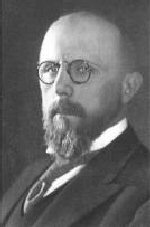
Alexandre Galopin was a Belgian businessman notable for his role in German-occupied Belgium during World War II. Galopin was director of the Société Générale de Belgique, a major Belgian company, and chairman of the board of the motor and armaments company Fabrique Nationale d'Armes de Guerre (FN). At the head of a group of Belgian industrialists and financiers, he gave his name to the "Galopin Doctrine" which prescribed how Belgian industry should deal with the moral and economic choices imposed by the occupation. In February 1944, he was assassinated by Flemish collaborators from the DeVlag group.

La Libre Belgique, currently sold under the name La Libre, is a major daily newspaper in Belgium. Together with Le Soir, it is one of the country's major French language newspapers and is popular in Brussels and Wallonia. La Libre was founded in 1884 and has historically had a centre-right Christian Democratic political stance. The papers is particularly celebrated for its role as an underground newspaper during World War I and World War II when Belgium was occupied. Since 1999, the newspaper has become increasingly liberal but is still considered more conservative than Le Soir.

The Military Administration in Belgium and Northern France was an interim occupation authority established during the Second World War by Nazi Germany that included present-day Belgium and the French departments of Nord and Pas-de-Calais. The administration was also responsible for governing the zone interdite, a narrow strip of territory running along the French northern and eastern borders. It remained in existence until July 1944. Plans to transfer Belgium from the military administration to a civilian administration were promoted by the SS, and Hitler had been ready to do so until Autumn 1942, when he put off the plans for the time being. The SS had suggested either Josef Terboven or Ernst Kaltenbrunner as the Reich Commissioner of the civilian administration.
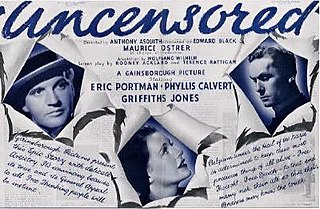
Uncensored is a 1942 British World War II drama, directed by Anthony Asquith for Gainsborough Pictures and starring Eric Portman and Phyllis Calvert. The film was produced by Edward Black, with cinematography from Arthur Crabtree and screenplay by Rodney Ackland and Terence Rattigan from a novel by Oscar Millard.
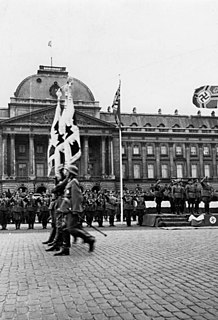
Despite being neutral at the start of World War II, Belgium and its colonial possessions found themselves at war after the country was invaded by German forces on 10 May 1940. After 18 days of fighting in which Belgian forces were pushed back into a small pocket in the north-east of the country, the Belgian military surrendered to the Germans, beginning an occupation that would endure until 1944. The surrender of 28 May was ordered by King Leopold III without the consultation of his government and sparked a political crisis after the war. Despite the capitulation, many Belgians managed to escape to the United Kingdom where they formed a government and army-in-exile on the Allied side.

The Belgian National Movement was a major group in the resistance in German-occupied Belgium during World War II with politically centre-right leanings.
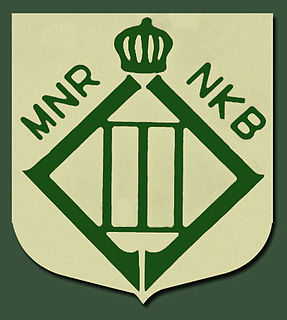
The National Royalist Movement was a group within the Belgian Resistance in German-occupied Belgium during World War II. It was active chiefly in Brussels and Flanders and was the most politically right-wing of the major Belgian resistance groups.
Paul Victor Antoine Struye was a Belgian lawyer, politician, and journalist, notable for his writings during World War II. A native of Ghent, Struye served in the Belgian Army during World War I. He qualified as a lawyer in the years after the war and also worked as a journalist at the Catholic newspaper La Libre Belgique. A royalist and patriot, Struye was soon attracted to the Belgian resistance during World War II and was influential once La Libre Belgique became an underground newspaper. His diary of life under occupation and writings on public opinion are important historical sources on the period. After the war, Struye entered politics in the Christian Social Party as a senator and held the portfolio of Minister of Justice (1947-1948). He subsequently held the post of President of the Senate on two occasions.

The Holocaust in Belgium was the systematic dispossession, deportation, and murder of Jews and Roma in German-occupied Belgium during World War II. Out of about 75,000 Jews in the country in 1940, around 24,000 were murdered during the Holocaust.

Marcel-Henri Jaspar, was a Belgian lawyer, politician, and later diplomat. He is best known for his unsuccessful attempt to establish an unrecognised Belgian government in London in 1940 during World War II.

Radio Belgique, also known in Dutch as Radio België, was a radio broadcast transmitted to Nazi-occupied Belgium from London during World War II. It was produced with the support of the Belgian government in exile and formed part of the BBC's European Service.
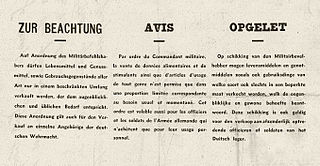
The Committee of Secretaries-General was a Belgian technocratic administrative panel created during World War II. The Committee comprised the head civil servants of most government ministries and formed a part of the German occupation administration of Belgium between 1940 and 1944, being an integral role in the Belgian policy of "lesser evil" collaboration. From August 1940, the Germans began introducing new members, and by 1941 its composition was almost completely different. Among those promoted were pro-Germans like Victor Leemans and Gérard Romsée, who had been involved in Belgian Fascist movements before the war. They helped to facilitate the more radical administrative reforms demanded by the Germans, although the Committee refused to involve itself in the deportation of Belgian Jews. As the visible face of the German administration, the Committee became more and more unpopular as the war progressed. Following the Allied liberation of Belgium in 1944, several members of the Committee were prosecuted for collaboration but several members, including Leemans, went on to political careers in post-war Belgium.

The German occupation of Belgium during World War II began on 28 May 1940, when the Belgian army surrendered to German forces, and lasted until Belgium's liberation by the Western Allies between September 1944 and February 1945. It was the second time in less than thirty years that Germany had occupied Belgium.

The Strike of the 100,000 was an 8-day strike in German-occupied Belgium which took place from 10–18 May 1941. It was led by Julien Lahaut, head of the Belgian Communist Party, even though the Nazi—Soviet Pact was still in force. The object of the strike was to demand a wage increase though it was also an act of passive resistance to the German occupation.

During World War II, Belgian prisoners of war were principally Belgian soldiers captured by the Germans during and shortly after the Battle of Belgium in May 1940.
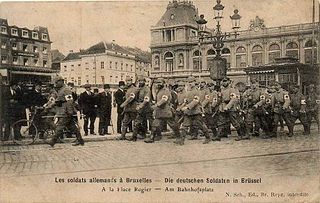
The German occupation of Belgium of World War I was a military occupation of Belgium by the forces of the German Empire between 1914 and 1918. Beginning in August 1914 with the invasion of neutral Belgium, the country was almost completely overrun by German troops before the winter of the same year as the Allied forces withdrew westwards. The Belgian government went into exile, while King Albert I and the Belgian Army continued to fight on a section of the Western Front. Under the German military, Belgium was divided into three separate administrative zones. The majority of the country fell within the General Government, a formal occupation administration ruled by a German general, while the others, closer to the front line, came under more repressive direct military rule.

Underground media in German-occupied Europe refers to various kinds of clandestine media which emerged under German occupation during World War II. By 1942, Nazi Germany occupied much of continental Europe. The widespread German occupation saw the fall of public media systems in Northern France, Belgium, Poland, Norway, Czechoslovakia, Northern Greece, and the Netherlands. All press systems were put under the ultimate control of Joseph Goebbels, the German Minister of Propaganda.
Geneviève Janssen-Pevtschin, also known Ginette Pevtschin, was a Belgian lawyer and the first woman magistrate in Belgium. She also was a distinguished member of the Belgian Resistance during World War II.


















